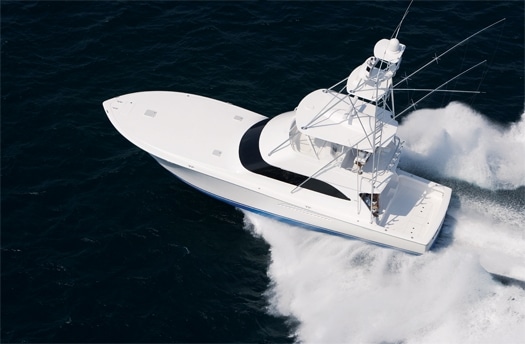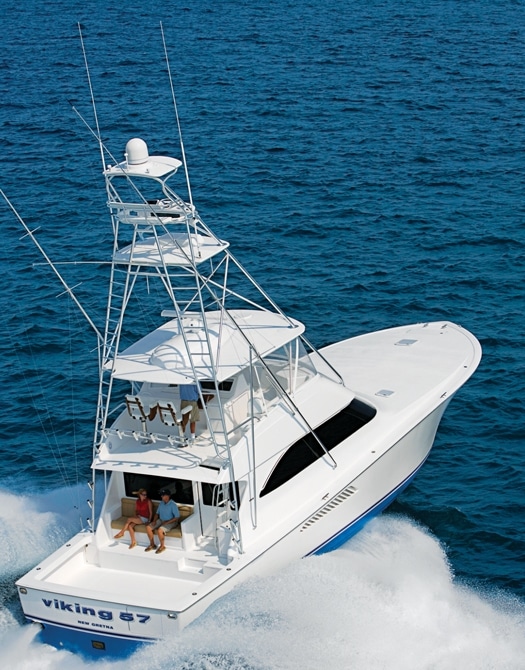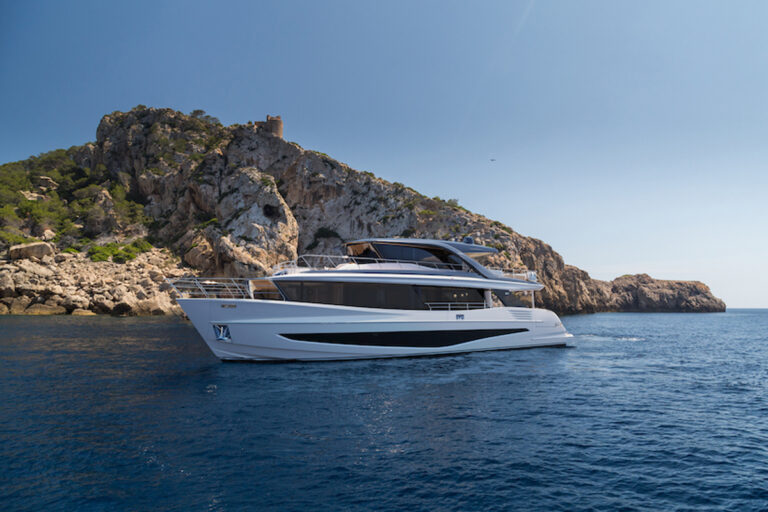
ytgjan5vike57525.jpg
The successful design and construction of a boat requires the thoughtful melding of art and science. A gracefully sweeping chine is of little value if it does not separate water from the hull side at speed and control spray. Performance is little satisfaction to an owner if the yacht doesn’t look the part. Viking Yachts understands how to apply this balance to the design and construction of tournament-grade sportfishing boats. The new Viking 57 Convertible demonstrates just how dialed in this venerable South Jersey boatbuilder is. When I spotted the 57 dockside, I was immediately struck by her good looks. They should not have surprised me, for in a sense, I know her well. Over the years I have tested most of her sisters, and a good friend of mine owned what you might say was her grandmother-the popular 55 Convertible, circa 2000. The 57 replaces the 56 introduced in 2004 and while the family resemblance is clear, Viking has skillfully managed her evolution. She is more refined than the boats that have come before her. Her stem rake and the aggressive sweep of her sheer and chine suggest speed. The soft corners and the generous radius of her transom follow custom tournament-boat fashion as do details like her faired exhaust ports and through-hulls. Above the sheer her lines are softer and rounder and she features a new low-profile bridge and teardrop window design. Her window line is carried forward by a painted band around her house-face and this, together with her low silhouette, adds visually to her length. To my eye, she’s a 10!

| | |
While innovations in design and fishing systems have typically been born in the custom boat cockpit, Viking’s capable fishing team and its many competitive customers have provided volumes of feedback from the field. The 57’s cockpit is arranged so that there is room to work around a full-size fighting chair. A large in-sole fishbox on centerline has a split hatch that can be opened from either side of the cockpit. Adjacent boxes can be configured as a livewell and a receptacle for an ice machine. All cockpit sole hatches are gasketed and fitted with positive latches. Tackle stowage and engineroom access are hidden beneath the seating, so spectators can enjoy the fishing from the cockpit mezzanine- this popular feature was often retrofitted on the 56 Convertible. A gaff locker extends from the cockpit forward under the side deck and an insulated drink box in the mezzanine step can be refrigerated. On the bridge, helm and companion seating face a console with clear acrylic lids over the electronics and a tournament-style pod in fiberglass with side-mounted single-lever controls. (Our test boat was fitted with the optional teak helm pod.) Engine electronic displays were located overhead on the underside of the fiberglass tower canopy. (I would opt to position them on the console, as it is easier on the neck.) Fore-and-aft bench seating adjacent to the helm incorporates a reversible backrest that can be positioned for lounging or observing. An insulated top-loading drink box can be refrigerated and is adjacent to the bench seating forward. Our test boat’s tower and electronics package were provided in-house by Viking-owned Palm Beach Towers and Atlantic Marine Electronics-all first class.

| | |
However, the 57’s tournament-boat innovations are not limited to the cockpit. In recent years, this market segment has proven a breeding ground for the sort of smart thinking that sorts out complicated systems. For example, the 57’s fuel system is virtually foolproof. Engines and generator draw from a single fiberglass main tank located under the cockpit. Fuel from a reserve tank forward is transferred to the main tank with a pump. (I would opt for redundancy by adding a second pump.) A single raw-water seacock and 120-volt continuous- duty pump serve the raw-water needs of most auxiliary systems, such as the livewell and the air-conditioning. Here again, the optional backup Viking offers would be a wise choice. Main engine raw-water intakes are plumbed with valves and sumps so that they can serve as an emergency dewatering system. These features and others are presented in a tidy Awlgrip-finished engineroom that rivals the high standard typical of the custom fishboat market. An electrically actuated sliding fiberglass door leads from the cockpit to the open main cabin. The layout and quality interior finish is typical Viking. Built-in settee seating has lift-top internal stowage that is ideal for tackle and cruising spares. A galley with under-counter refrigeration and a service bar are steps from a dinette. While the 57’s three-stateroom, two-head arrangement is similar to the 56’s, an offset passageway allows for a more efficient use of space. The master stateroom has an athwartships queen island berth, his-andhers maple-lined hanging lockers, and a private head with a shower. The VIP stateroom has a queen island berth. Upper and lower crossover berths are offered as an option. The third stateroom has upper and lower berths and the second head has private access from both staterooms as well as access from the passageway. A stacked laundry station is hidden in a locker in the passageway.

| | |
But performance is the bottom line for competitive fishermen and the 57 should please those focused on getting to the fish first. During our sea trial in 2- to 4-foot seas off Palm Beach, I recorded a maximum speed of 39.3 knots. At 2100 rpm she managed a bit more than 35 knots and the MAN engine electronics indicated a fuel burn of 124 gallons per hour. I found loafing along at 29.3 knots (1800 rpm) pleasant and relatively efficient and noted a fuel burn of 88 gallons per hour. Sight lines from her helm are excellent and she is responsive and predictable at speed or when maneuvering in close quarters. Our test boat was fitted with a bow thruster, which seemed like overkill considering the 57’s generous allotment of horsepower. The base price for the 57 with the standard 1,360-horsepower MANs is $2,125,000. Our tournament-ready test boat, fitted with the 1,550- horsepower MANs tipped the scale at about $2,700,000. Her stout list of options included a tower, electronics, and a cockpit ice machine. Add a watermaker and you are ready for billfishing in the Bahamas. As seems to happen with every new Viking convertible, the 57 raises the bar and she will surely raise fish. For those who appreciate the art and science of tournament boat design, she is sure to please the senses. To see even more Viking 57 Convertible pictures check out. Viking Yachts, (609) 296-6000; www.vikingyachts.com









